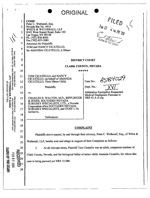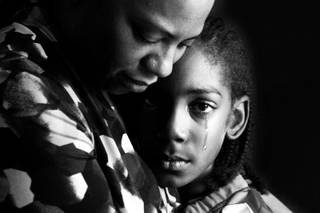Sunday, Dec. 26, 2010 | 2 a.m.
Do No Harm: Hospital Care in Las Vegas, Part 5
- Sun investigation reveals flaws in hospital care; solutions offered
- How to put patients first
- Local hospitals’ willingness to change culture would be a step toward better care, transparency
- ‘You can’t kill my mother and get away with it’
- We must adopt a culture of sincere care
- How to file a complaint
Share your stories
Do No Harm: Brian Greenspun
Sun Publisher and Editor Brian Greenspun talks about the findings of the newspaper's series on hospital care. To address the problems raised by the series will require a change in attitude from executive suites down, including more openness with patients and a commitment to do no harm.
AUSTIN, Texas — This is an insurgency no one wanted to join.
The patient safety advocates who gathered last month for their annual strategy session were drafted by tragedy — a botched surgery, a preventable infection or some other hospital incident that launched them into battle to protect others from suffering harm when they seek healing.
If America’s patient safety movement has a war room, this is it. The annual Safe Patient Summit organized by the nonprofit Consumers Union is where activists plot strategy toward their goal: nothing less than the reformation of America’s health care culture.
There’s Patty Skolnik, whose son died after suffering brain damage because of surgical errors. A Colorado law named in his honor gives patients access to important quality information about doctors.
There’s Pat Mastors, who after losing her father to a hospital-acquired infection, lobbied successfully for patient safety laws in Rhode Island.
There’s Mary Brennan-Taylor of Buffalo, N.Y., who lost her mother, Alice Brennan, to three hospital-acquired infections.
“We’ve got a long fight, but I’m not going to give up, and I know you’re not going to give up,” she told the group of about 30 activists. “You can’t kill my mother and get away with it.”
The group is united through common experience and goals, but lacking a centralized authority to direct and organize its work. Hence, the need to gather and exchange notes. One session in the two-day summit included brainstorming about effective strategies and possible leverage points for reform.
It’s difficult to pinpoint when the patient safety movement began. But it was vaulted into the national spotlight in 1999 when the Institute of Medicine released a report, “To Err Is Human,” finding that as many as 98,000 people a year die in hospitals as a result of preventable medical errors.
The problem may be getting worse. A November report by the federal government estimated that nationwide 15,000 Medicare patients die every month as a result of being harmed in hospitals.
The Las Vegas Sun over the past six months has reported extensively on injuries and deaths in Southern Nevada hospitals, including 3,689 cases of preventable patient harm identified in billing records in 2008 and 2009.
“There’s no shortage of new victims,” said Helen Haskell of South Carolina, whose 15-year-old son, Lewis, died in 2000, four days after a minimally invasive cosmetic procedure.
Haskell, president of Mothers Against Medical Error and director of the Empowered Patient Coalition, said the movement is growing but has not yet had any noticeable effect in reducing the number of patients harmed while hospitalized.
Reform is slow in coming because hospitals and doctors are not directly accountable — financially — to patients and provide little transparency, said Haskell, who was named one of the “100 Most Powerful People in Healthcare” in 2009 by Modern Healthcare magazine.
“The customer doesn’t pay directly, and they (hospitals and doctors) keep everything to do with price and quality secret,” she said.
John James, a Houston toxicologist, lost his son in 2002 when cardiologists failed to diagnose — even though he was an avid summer runner — his levels of the electrolytes potassium and magnesium were dangerously low. James said hospital patients need a bill of rights. He proposes it require:
• Showing patients their records on a daily basis. “Medical records are a playground for doctors,” James said. “You should have a right to see them every day and see that they reflect what took place.”
• Informing patients about the competency of their physicians, including whether they are board certified or have been in drug rehab.
• That doctors use methods backed by medical research and administer medications only for Food and Drug Administration-approved purposes.
• Informing patients and getting their permission to perform surgeries in ways that clearly explain risks and do not use fear to manipulate decisions.
Compared with the wealth of the nation’s hospital industry, activists have negligible resources. What they do have, and what they say is hard to dispute, is a righteous pursuit of justice that’s fueled by pain.
John Torello of the Connecticut Center for Patient Safety stood at the front of the room during one work session, holding his laptop for an impromptu screening of a home movie of his twin 4-year-old boys, Michael and Matthew.
When Michael was born he had jaundice that went untreated despite the Torellos’ pleas to doctors and nurses. Jaundice is easily cured by placing a baby under special lights.
As a result, Michael suffers from kernicterus — severe brain damage that makes it impossible for him to control motor functions.
In the video, Michael sits in a chair, barely able to respond to his mother’s voice and unable to control his muscles, while Matthew chatters and bounds about the kitchen like a typical boy.
The Torellos have worked with the hospital to produce a video stressing the importance of patient safety to medical residents, new employees, students and staff.
“They have their lobbyists and all their money, but you have your story,” Torello told the group. “Those stories are really what get people moving.”




Join the Discussion:
Check this out for a full explanation of our conversion to the LiveFyre commenting system and instructions on how to sign up for an account.
Full comments policy